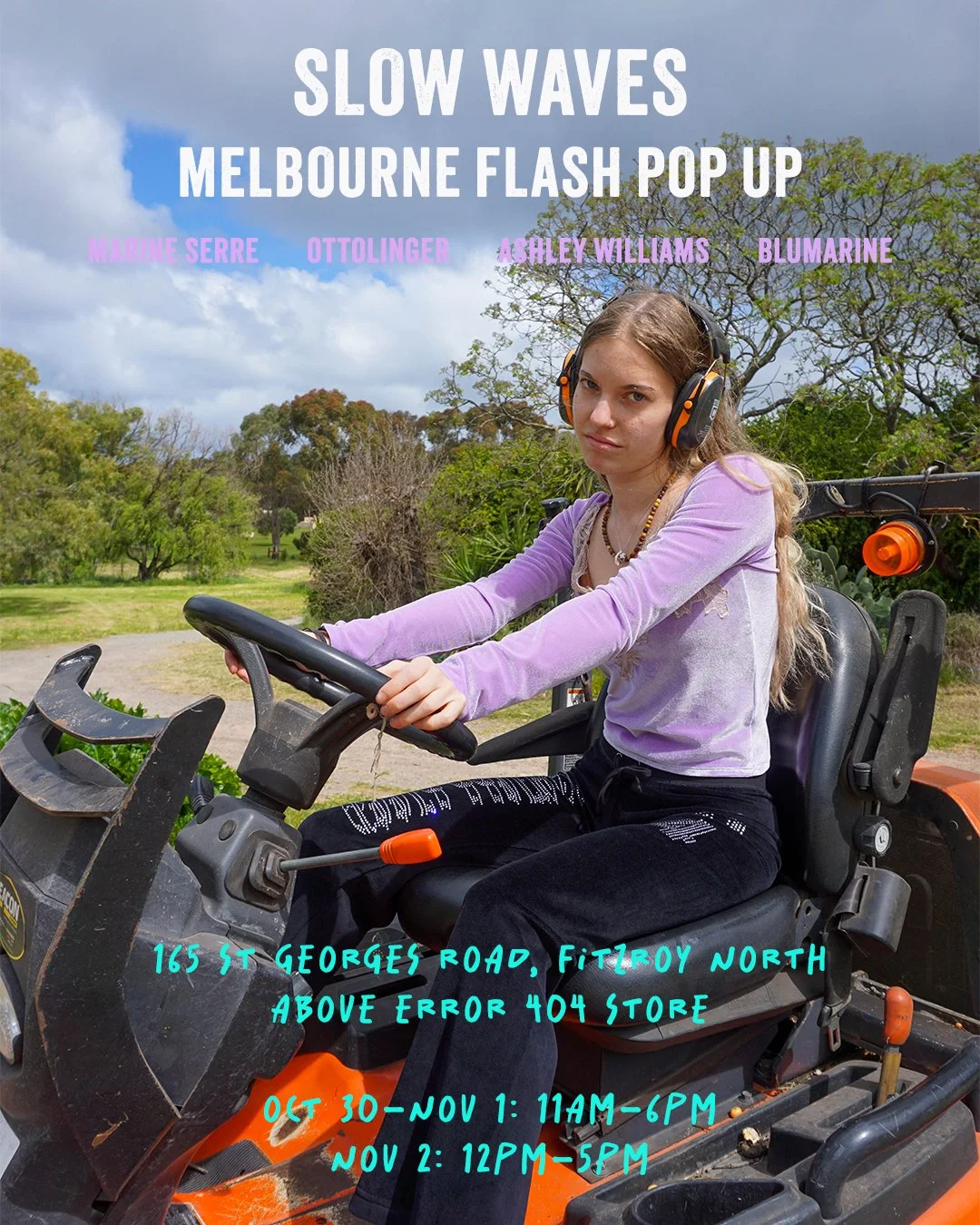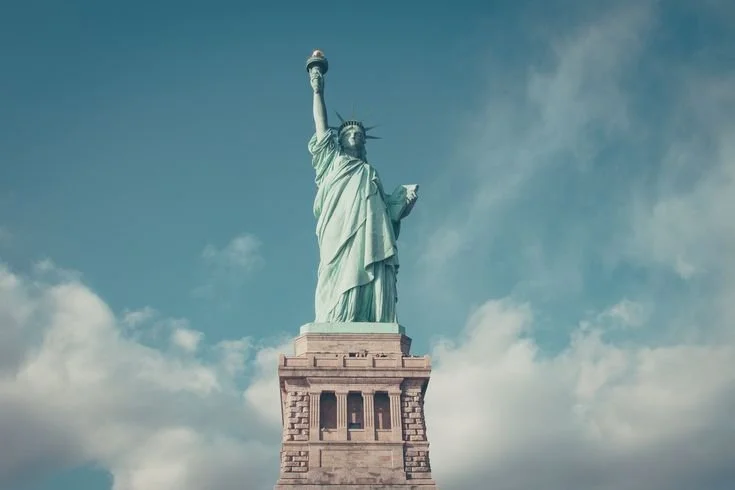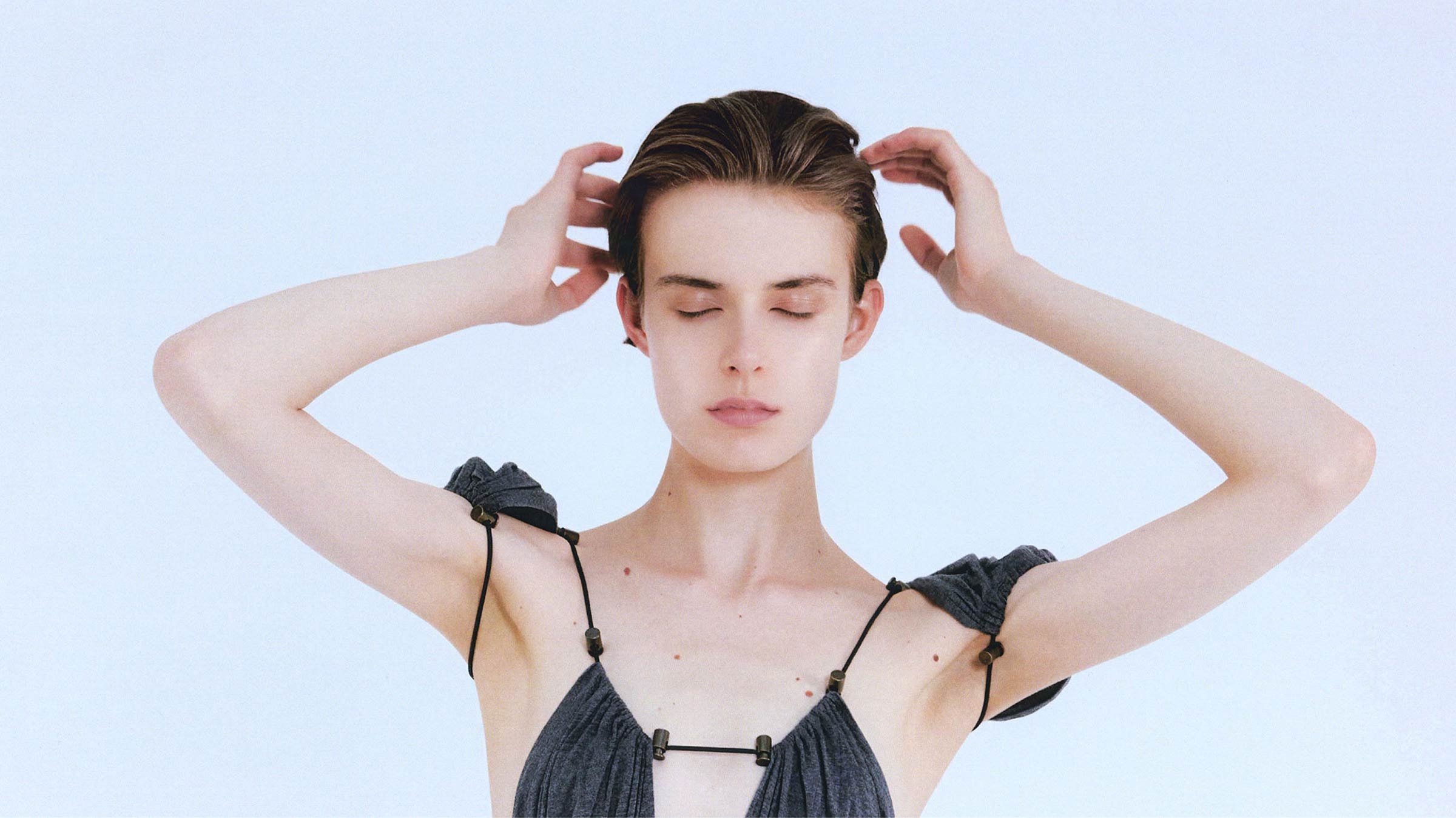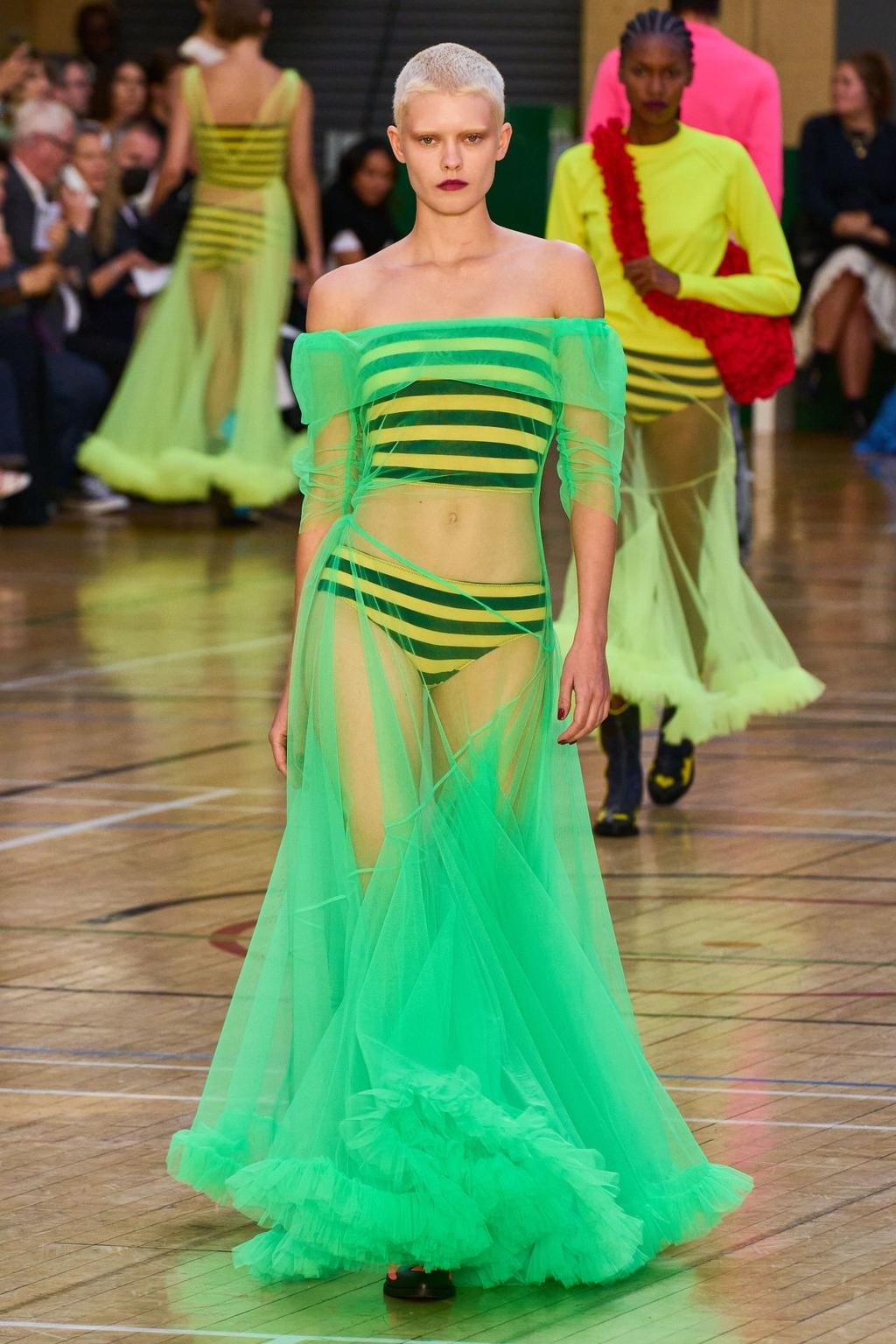Shipping To The US Resumes /
Good News: We are shipping to the US again!
Bad News: New tariff requirements :(
We are pleased to announce that shipping to the US via Australia Post has resumed, following a temporary suspension caused by changes to customs and import tariff rules made by the US Government.
All orders now have duties applicable (and additional fees) to be paid by us to US Customs Border Protection before they reach the country.
As a result, all US orders are subject to a 15% fee to cover duties paid and third party fees. Please note there are no additional fees to be paid by the customer once goods reach the US.
The 15% fee is subject to change as we monitor the situation.
If you have any questions or would like to know how we can support you further, please email us at online@slowwaves-store.com
The Goul Next Door: Imogen Wilson x Slow Waves /
A film by Imogen Wilson x Slow Waves
Visuals by Imogen Wilson @it.girl.misery
Model @franchesxkaa
Assistant @_mimmosa
Beauty @carlylim_makeup
Nails @mannequin.hands
Titles @flosskees
Sound @_crimespree
Casting @mimi.casting
DOCUMENT JOURNAL: Aesthetically Incorrect- Inside the Glenn Martens universe /
By Drew Zeiba
The “designer’s designer” talks Y/Project, bad taste, and the Belgian disposition towards beauty
Glenn Martens might be one of Europe’s busiest designers. On top of leading the cutting-edge label Y/Project for the past decade, since 2020 he’s helmed Diesel—while making time to take on couture shows for Jean Paul Gaultier (for whom he worked as a menswear designer, just after graduating from Antwerp’s Royal Academy) and to put forward collabs with the likes of Melissa, UGG, and JPG.
Martens grew up in Bruges, where he attended a “very classic” high school whose ordinary career directions he wasn’t “vibing towards.” He drifted into interior design for its seemingly logical architectural underpinnings and discovered his interest in creative practice—but quickly tired of the need for furniture to be “really functional.” Some might say the same of fashion, but this casual dismissal of strict utility is distinctly Martens. Across the brands he’s designed for—and perhaps most pronounced in his ANDAM award-winning work at Y/Project—his concept-forward garments stand as wearable aesthetic manifestos. Layered, twisted, printed, folded, jagged, crumpled, slanted, oversized: Y/Project products (“of course, you completely can’t get rid of the product”) repurpose “archetypal” materials like denim, wool, and leather—or trompe l’œil versions of them—to avant-garde ends.
As of late, Y/Project and Diesel have been attempting to mitigate some of the inherent ecological damage of fashion production, introducing recycled and deadstock materials, organic cotton, and “evergreen” capsules set to outlast the fashion cycle, as well as QR-coded tags that might educate consumers. (“I say to my team, We should be the Mother Teresa of clothes. They’re trying very hard,” Martens remarks.) Plus, he is first to admit, today’s designer is more than a designer: The contemporary “creative director” is called upon to cultivate a vision through runway shows, stores, events, ads, and all manner of brand messaging. With projects ranging now from mass-market undergarments to haute couture, Martens considers how to direct his range of platforms to speak within and beyond the fashion microcosm. “That’s the great thing about the fashion industry,” he says. “There are so many different ways of talking.”
Drew Zeiba: You’ve got a lot going on—Y/Project, Diesel, the Spring/Summer 2022 Jean Paul Gaultier show. How is it stepping into these different roles? Do you feel like you’re occupying different versions of yourself, or do you see it more holistically?
Glenn Martens: I actually am a different version of myself. I once made a joke about having multiple personalities, and the journalist wasn’t so happy about it. [Laughs] I’m sorry, I shouldn’t make that joke anymore. But it’s true. At Diesel, I’m really Diesel. And then at Y/Project, Y. At Jean Paul Gautier, I did couture and I really had my couture fingers on. I mean, at the end of the day—to talk about those three again—they do have something similar in their ethos. They make jokes. They don’t take themselves too seriously. There’s always a fun factor, an irreverence in there. So the fundamental values are quite similar; it’s just how to translate them. With Y/Project, it’s about garments. It’s really about the construction of the garments.
Drew: In the New York Times, Vanessa Friedman called Y/Project a thought experiment. How do you turn these ‘experiments’ into garments?
Glenn: Vanessa Friedman said something like I’m the designer’s designer. That was actually a compliment. I try to do the designs that nobody has done yet. Like, let’s try to surprise ourselves and other people. What I started 10 years ago is still the same—it’s quite rich, it’s really explosive, there’s something royal in there. I think it comes a little bit from my obsession with history and art history, and also growing up in Bruges, where everything is medieval and overwhelming. I really love this kind of world. It’s a bit decadent in that way.
Then, of course, Y/Project is also disposed to a realistic vibe, which is maybe also quite connected to Belgium. And then, violà. There’s never a strict concept for the season. It’s never, I saw this film and… The starting point is very me in the studio, saying, ‘Let’s surprise ourselves on construction.’ By now, my team has complete carte blanche. They can do whatever they want as long as we try to shock ourselves. Every season has a moment where we’re doing fittings and thinking, Are we seriously going to do this? [Laughs] It’s that border of good taste, and also what is acceptable or not. It’s about having fun and experimenting as much as possible.
“By now, my team has complete carte blanche. They can do whatever they want as long as we try to shock ourselves.”
Drew: When you first became creative director at Y/Project, did you feel you were diving into its existing DNA? Or was it more that you were trying to figure out how to make it your own without throwing out what you’d inherited?
Glenn: I was, of course, in a super complicated position, because the initial founder, Yohan Serfaty, tragically passed away. There’s no proper way of taking over a brand in mourning. It was tricky, emotionally. I obviously stayed closer to Yohan in the beginning. But the thing was that we were actually a very small company with a very small output, with, like, 12 stores. And everything was actually very much connected to Yohan, because he was a very enigmatic character, and he would really draw the collections for himself. He was literally dressing himself. He was making his own wardrobe. People who bought into that collection also bought into Yohan. When he passed away, there was no point really to continue that, because I wasn’t that person. There was no one else that could do it but him.
My creative world is very opulent and decadent, and there’s fun factor, and it’s also a bit trashy. Regardless, I think the technical-ness—that starts from Yohan. Because from the beginning, you had leather. That was a very clear way of constructing very sharp, very directional lines, which I think you can still find at Y/Project. Even though it’s not leather-based anymore, how we construct clothes [refers] to that. And then it was also the whole budget situation. At a certain point, we were like, Let’s split into womenswear—great, great, but there wasn’t budget for womenswear. [Laughs] So we had to find solutions. A lot of the garments that I was designing were versatile in wearability. And you could put them on the menswear, and then, one month later, on the womenswear. Nobody would notice that, actually, it’s the same jacket. Things are adjustable, twistable—you can give them different moods.
Drew: You have mentioned bad taste and trashiness more than once. What’s bad taste to you—and why do you like it?
Glenn: Bad taste… I don’t know. Bad taste, of course, is very subjective. I mean, I’m mostly thinking about bad taste for me, because I’m a very plastic-schools person, and I come from Belgium and the West, and I was very much obsessed by this classic, occidental aesthetic in the beginning. Stepping away from that [means] maybe including things that are not as balanced aesthetically. A lot of the garments we do at Y/Project are not there to be aesthetically correct. I mean, we’re not like brands like Dries Van Noten or Balenciaga or whatever, which are all about the aesthetic silhouettes. Of course, there’s conceptualism in there, too, but the main thing is this kind of elegance and beauty. At Y/Project, we don’t insist on that so much, though it’s always nice when it happens.
It’s also a mindset. Even though I was just saying Bruges was a very beautiful, medieval town, that’s really the exception of the rule in Belgium. Belgium is a very ugly country. It’s one big industrial zone; there are factories everywhere. It’s not like living in upstate New York or whatever, or Italy or France, where everything is pretty and joyful. So as a Belgian person, you are kind of obliged to find beauty in a bit of an unexpected way, and to try to look at things differently, and to appreciate things for a different reason than just beauty.
Drew: To return to talking about material and form—it seems that one way to put forward clear concepts across a collection is to reduce other elements. How do you balance complexity and simplicity?
Glenn: A lot of the time, we go for super archetypal materials because the garment is always so expressive. On top of that, to put experimental materials—I mean, it just becomes a costume. And so at least there are connection points to something that you know. The construction is already so experimental, I think it’s nice that we work to stay with something referential to help ground the design, and to add a little bit of a reality factor.
Drew: You can’t defamiliarize if there’s nothing familiar to start with. And that also ties back to the many ways you can use the garments.
Glenn: It translates much deeper into the clothes. As we are talking about versatility all the time, it means that one jacket can be worn by so many different people for so many different reasons. You can slick it down, you can make it more sexy, you can make it more deconstructed, you can do whatever. There are a lot of different ways to embody a garment—meaning it’s a very diverse way of working. Diesel is much more in-your-face. I mean, the greatest thing about this is that it’s a very global brand. That’s one of the reasons why I took it. With Y/Project, I can scream as much as I want about social sustainability, about environmental sustainability—great. We have a massive evergreen capsule which is completely sustainably and circularly produced—but still, who do I talk to? I only talk to a few people who are really into fashion.
Y/Project, we’re not mainstream in that way. But at Diesel, I touch everybody. It’s a lifestyle brand more than a fashion brand. And on top of that, it’s a lifestyle brand which has had 20 years of engagement with a very hetero-norm clientele—which we really love, and I think it’s really amazing. My brother loves Diesel, fantastic. But it also means that we are very popular in countries that are not the most politically open. So, for example, doing the Tom of Finland collaboration—if we did it with Y/Project, those fashion people would love it. But with Diesel, it’s way more aggressive. I mean, the amount of hate I’m receiving.
Drew: Oh?
Glenn: It’s crazy—people wish me death. [Laughs] And I think that’s exactly what we need to do, and that’s the reason why I do it. Because we touch every single person, it’s very important to give clear messages. A gay couple kissing at Diesel is way more loud than anything else you could do within the luxury business. A lot of people hate me, of course.
“You can slick it down, you can make it more sexy, you can make it more deconstructed, you can do whatever. There are a lot of different ways to embody a garment.”
Drew: Wait, you’ve been getting actual death threats?
Glenn: Every year I get a few death threats at Diesel. Every year. And I’m like, Woah. I have to admit, the first time, I was really freaking out. But now I just think it’s funny.
Drew: Well, at least people are paying attention, I guess. And sex and fun stay part of the projects.
Glenn: That’s also one of the reasons why we go for archetypal materials—because we do need to ground it, and we need to bring that sexuality in there. I think there’s something in all of the brands that does this: Like, this is a garment which is quite flirtatious. Even with a more conceptual brand like Y/Project, there’s this flirtatiousness. I mean, I work a lot. I really work all the time. It’s my calling. And I’m very blessed, because it’s also my hobby and my passion. But I’m working seven days a week, and at the end of the day, I’m a person who takes a lot of time to adjust again. For example, with Fashion Week and socializing every day, it would be very impossible for me to leave to the countryside of Normandy and sit in a garden.
Drew: Your body would be vibrating.
Glenn: I’d just be obsessed, on my iPhone. If I take off during the year, it has to be active things, like going hiking. But if I only have the luxury to take off a weekend, which I mostly don’t, then just going partying and getting drunk is really easy. Go dance, whatever, be super intense; get a hangover the next day and then you go back to the office—voilà. Everything’s been quite intense. I like intense-ness.
HYPEBEAST: ANCUTA SARCA SS23 /
Ancuta Sarca's Hybrid Footwear Embraces Monstrous Attitudes In SS23 Campaign
By Andrea Sacal
Model Soo Joo Park enters the designer’s wild mind.
London-based designer Ancuta Sarca has been at the forefront of the British footwear scene, proving that innovation is a constant. The Fashion East alumni has graced London Fashion Week‘s stage for the past few seasons, presenting an array of futuristic styles with a sustainable outlook for Fall/Winter 2023.
The season prior, Sarca collaborated with Vans on a line-up of deconstructed formal footwear and stepped into clothing by joining SKIMS for an exclusive shapewear range. Now, the designer has unveiled her all-new Spring/Summer 2023 campaign.
Shot by photographer Zach Apo Tsang, the campaign sees model and musician Soo Joo Park assume a monstrous identity by playing with proportions to create otherworldly visuals. Additionally, the campaign catches Ancuta Sarca’s latest creations in action, presenting gladiator-style metallic pumps with oversized branded tongues and textile detailing.
Elsewhere, Park is set forth on a journey carrying leather briefcases while rocking Sarca’s gradient knee-high boots featuring Nike uppers and eye-catching medial Swooshes. The model heads underwater wearing neoprene designs, also revealing velvet sandals paired with summer-ready swimwear and arm sleeves. Finally, the designer’s SS23 mules shine bright, previewing the unisex model in white and red mesh with silver accents.
VOGUE UK: MOLLY GODDARD SS23 /
5 Things To Know About Molly Goddard’s Happy-Making SS23 Collection
By Alice Newbold
Back in Seymour Leisure Centre for a third season, Molly Goddard is enjoying having a spot that feels like hers for a while. The high ceilings and light streaming through the windows certainly made for an apt setting for a daytime London Fashion Week show she hoped would go “bang, bang, bang… and feel kind of relentless”. From the bold new accessories to the romantic finale, here’s everything you need to know about Molly Goddard’s spring/summer 2023 show.
SS23 is an ode to making
Self-deprecating to a fault, Goddard is not one to wax lyrical about the layered inspirations behind her work. She’s a doer, preferring the process of creating to ruminating on what makes a good press release. For spring/summer 2023, Molly is keeping her artistic references to herself and sharing her love of making. An edit of dresses riffing on toiles – “they’re perfectly finished dresses, but I just think they look amazing in calico” – looked understated in Goddard’s world, while the topsy turvy pieces, such as gowns made from jersey material, also looked “so right, when they should be wrong.”
“Jumbled up” never looked so good
Goddard thrives on finding new ways of creating volume and structure for her signature silhouettes, and is now in a happy-making rhythm of clashing prints and colours too. “There’s a messiness to this season, which I really like,” says the creative, whose brief to the sound engineers was to make something “a bit jumbled up and not too slick”. Mission accomplished. Guests lining the hanger-like space bopped in their seats and, as always, left feeling buoyed by all that bouncy, attitude-laden tulle.
Cowboy boots are on the agenda
Molly Goddard shoes always contrast the clothes and become a talking point in their own right. How does one top a skyscraper platform Ugg collab? Two words: Cowboy boots. “They are a great way to add more colour,” asserts Goddard, who sees fashion palette potential in everything. The perfect companion for those yeehaw knee-highs? The densely-frilled velvet bags that look suitably eccentric next to Goddard’s personal favourite piece: the ’50s-style collared cardis, which looked particularly great on the guys.
The show closed with three special bridal dresses
“I think I’m old-school in my approach to doing shows and I’ve always loved the classic bridal end,” says Molly, whose wedding dress finale was anything but traditional. Three bridal looks closed the show on a high and naturally swept social media. The last gigantic fantasy creation took seven days to make and almost filled the atelier, which was lined with paper to protect the frothy fabric. “We kind of made it as we went along as it was hard to gauge how big it was,” explains Goddard, adding: “It’s pretty big.”
The wedding wear is rooted in Molly’s feel-good mission
Goddard’s bridalwear business is not about her bottom line, but the joy associated with making someone feel their very best on their big day. Molly’s brides are not trussed up to the nines in Spanx, but at ease – and dance floor-ready – in dresses that command attention without being remotely fussy to wear. “The point of it all is to have a really great time,” says Goddard, whose new work signals celebration – much like everything she has ever done. From the retina-searing neon separates to the dreamy white wedding gowns, Molly Goddard partywear still makes London hearts soar.
LE MONDE: Glenn Martens and Stéphanie D'Heygere, the art of forging a friendship /
Both trained at the Royal Academy of Fine Arts in Antwerp, Belgium, the two comrades have been exchanging as in a game of ping-pong for almost fifteen years.
By Valentin Perez
“Glenn was in a promotion above mine. As he had gone through all the imposed projects, I always asked him for advice, his opinion, ” recalls Stéphanie D'Heygere, referring to Glenn Martens, who also studied at the Royal Academy of Fine Arts in Antwerp. , in Belgium.
“The first skirt made by Stéphanie at school was a very experimental XXL cushion which came to surround the body of the model”, cafte the person concerned. Her: “Pfff… That sucked! I thought I would be fired the first year…”
Proof that transmission is not just a matter of blood ties or generation, they have been exchanging like in a game of ping-pong for fifteen years. "We don't always agree, but we enrich each other, we discover, we learn together", they say together. Glenn Martens, artistic director of Y/Project since 2013, has made this Parisian label an exciting and sensual deconstructed label.
At her request, Stéphanie D'Heygere imagines the jewelry and certain accessories. "Of the people I work with, Stephanie is the one I've known the longest," says Glenn Martens. Psychologically, this reassures me. She's always there, smoking her cigarette before the show and saying to me: "Yes, it's going to be very good, it's your best collection!" She has the comforting presence of a little sister.
A Flemish sense of fitting in
Both come from Flanders: Stéphanie, daughter of an interior designer who introduced her to style, from Courtrai; Glenn, who inherited a taste for history and its connection to clothing from his parents and studied interior design, from Bruges. Same appetite for “bons vivants”, same playfulness and black humour. "The Flemish sense of getting in," they laugh, cigarettes in their mouths, with the same accent of the West Belgians. “We have this subtitled Flemish accent even on Flemish TV! , she laughs , when he remembers that he had to exchange in English with his teachers in Antwerp, so much the latter had difficulty understanding him.
At university, their end-of-studies collections already had a bit of the flavor that their work would later take on: an architectural ready-to-wear, turned upside down for him; a second-degree diversion of everyday objects in a surrealist perspective at home, who invents, for her personal label, D'heygere, card holder rings, cigarette holder loops... Barely landed at Y/Project in Paris, in 2013, Glenn Martens calls on his friend, then a consultant. It offers a leather belt whose aluminum buckle forms a Y. It's cardboard.
Since then, spiral earrings or earrings depicting positions from the Kama-sutra, tribal piercings, lacquered brass flowers have been born out of their dialogue. “Between us, everything is very fluid, ” they explain. You only need two appointments per season to work . We share ideas, photos by SMS, all between a joke and a heart emoji. In addition to their friendship, they have noticed that it is "a taste for the conceptual" that binds them. A camaraderie that the two accomplices, always ready for the next joke, the next text message, the next cigarette, do not intend to break anytime soon.
HYPEBEAST: Y/PROJECT FW22 /
Y/Project's Glenn Martens Has a Taste for Trompe-l'œil
Debuting the label’s FW22 collection ahead of his special residency for Jean Paul Gaultier.
Ahead of Glenn Martens‘ one-season residency debut for Jean Paul Gaultier, Y/Project has taken to Paris Fashion Week to serve its Fall/Winter 2022 collection that’s infused with the Gaultier touch.
Dominated by trompe-l’œil, illusionary graphics could be made out from the vast space as something that flirts with and questions gender as a concept. It’s something Gaultier has been doing for years, working with body prints and anatomical graphics to redefine the wearer’s form, and something Martens was keen to explore: “We took one of his most iconic prints and we interpreted it in a Y/Project way. It’s very layered — you have men’s prints and women’s prints and they go on top of each other,” Martens explained to Vogue.
Arguably Martens’ greatest collection for Y/Project since his appointment as Creative Director in 2013, the FW22 presentation saw heatmap-esque graphics offering a voyeuristic peek into what lies beneath; however, by using trompe-l’œil the graphics subvert expectations as they appear on everyone. As such, a muscled ab-packed top can be seen underneath a suit that’s covered in the same purple and green-toned illusionary effect, while a Y2K miniskirt is adorned with a phallus graphic.
Elsewhere, Y/Project’s usual array of denim is presented in full force. Jackets are oversized and drape from the shoulders, meeting pleated skirts halfway for a full ensemble, while other double-denim looks are again covered in trompe-l’œil before being twisted and rearranged in the brand’s typical manner.
By Eric Brain for Hypebeast



























